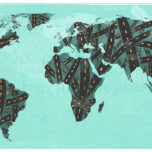December 6, 2018 — A tsunami of development projects is sweeping across the planet. It’s in the form of new roads, dams, mines, housing estates, and other infrastructure projects. The governments enabling these projects tell us not to worry: although the details vary from country to country, nearly all sizable projects must undergo an environmental impact assessment (EIA) to ensure no lasting harm.
But the sad fact is, those assessments are increasingly not worth the paper they’re printed on.
The EIA is the frontline of environmental protection in most countries. It’s a legal requirement placed on a developer to measure the impact on nature of their proposed development. If that impact includes anything the government has pledged to protect, such as a threatened species, then the development may be halted or redesigned to avoid the impact.
Or that’s the idea, anyway. The only problem is that the EIAs are rarely stopping bad projects. All around the world we see a growing catalog of cases where EIAs are giving green lights to developments that should never see the light of day — projects that are destroying irreplaceable habitat or threatening the last representatives of endangered species. For example:
One EIA gave the thumbs-up on a housing project being carved out of Panama’s tropical forest because it reported only 12 common bird species present in the area. But a bird expert did his own survey of the same area and and identified 121 bird species — including several rare and threatened species.
Another EIA for a 900-kilometer (500-mile) highway slicing through the heart of Brazil’s Amazonian rainforest concluded that the project would cause no net increase in deforestation. Yet independent analyses suggest that by 2050 this project will provoke additional forest losses of up to 39 million hectares (96 million acres) — an area larger than Japan.
The approval of a hydropower project in North Sumatra was based on an EIA that was so utterly rife with inaccuracies and misrepresentations that 24 other scientists from around the world and I wrote directly to Indonesian President Joko Widodo, decrying its blatant distortions. Today, this project is bulldozing ahead, cutting across the scarce remaining habitat of the critically endangered Tapanuli orangutan — the rarest great ape species in the world.
Designed for Failure
Why aren’t EIAs doing their job? Here are four big reasons:
Inadequate Investment. Rigorous assessment takes time, effort and resources. For example, detecting threatened species— one of the main things EIAs are supposed to do — is technically challenging and expensive. Limiting EIAs to “quick and dirty” assessments saves money and also helps avoid detecting rare species that might block the development.
Insufficient Scope. The impacts of any development are rarely confined to its planned footprint. Large mining projects in the Amazon, for example, have caused sharply increased deforestation up to 70 kilometers (43 miles) outside of mine sites. This is because the mines require new forest roads and those, in turn, promote illegal land encroachment and forest loss. Similarly, few EIAs in Malaysia consider the chronic increases in poaching, habitat fragmentation and other human pressures that occur when a new road slices into a forest. And in the Amazon, roads create broad “deforestation halos” — with 95 percent of all deforestation occurring within 5.5 kilometers (3.4 miles) of a legal or illegal road. In yet another example, EIAs for large dams in Brazilian Amazonia have consistently underestimated the size of the area that will drown under reservoirs — by 65 percent, on average.
Vested Interests. Why don’t EIA assessors simply try harder, do the job properly, and extend their assessment to incorporate all impacts related to the development? In short, vested interests. Most governments require the developer to fund the EIA. And the last thing the developer wants is an EIA that stops it dead in its tracks. Assessors (mostly private consultants) who conduct stringent EIAs may be blacklisted by other developers in the future.
On occasion, one even sees EIA consultants defending and promoting the project in public — which is like the judge in a murder trial testifying for the defense. On occasion, one even sees EIA consultants defending and promoting the project in public — which is like the judge in a murder trial testifying for the defense. In northern Queensland, for example, experts were stunned last year to see an EIA consultant publicly defending a major resort development, known as KUR-World, that he was being paid to be objectively assessing.
Poor Governance. How do developers get away with such poor outcomes? The answer is inadequate governance. Governments responsible for ensuring the integrity of the EIA process are failing to ensure it actually happens at the level required. Governments have vested interests, too. Development is usually equated with economic growth and jobs, and politicians can turn these benefits into votes. Add to that bribery and corruption, which is rife in many developing countries, and it’s easy to see how developers often gain an unhealthy hold over political and governance processes, including the EIA.
Prepare for the Tsunami
In the coming years our planet will see incredible development pressure, including 25 million kilometers of new paved roads and over 3,700 major hydropower projects.
Assessing such impacts in a way that prevents or greatly limits their environmental impacts is technically doable; the science is available. A greater challenge, however, is demanding appropriate transparency, accountability, and compliance around our assessment efforts. Without those ingredients, we are hopelessly unprepared for the development tsunami.
Here are eight things we can do to help:
- Demand EIAs be made freely available online, and that anyone be allowed to comment on them. Governments often allow only local residents to comment on EIAs, but many projects have regional or global effects. Limiting comments also excludes top international experts, such as hydro dam or mining specialists, from providing critical advice.
- Expect bribery in big projects. Many projects that should never be approved get the thumbs up because key decision-makers have been secretly paid off by the project proponent or land developers.
- Insist the public be allowed to comment on projects early in the approvals process, before a project gains momentum. Many developers try to ram projects rapidly through the approvals process – and by the time the public is allowed to raise concerns, the project is virtually a fait accompli.
- Call out EIAs that recommend approving projects with only minor “tweaks” that make the project seem palatable but are actually superficial and minimally effective. Fish ladders around big dams, and underpasses beneath highways, are examples of expensive measures that have only small benefits for sensitive wildlife.
- Say “no” far more often. Many proposed projects are simply a bad idea — with spates of serious environmental, economic, social and financial risks — and should be canceled altogether. Saying ‘yes’ to bad investments was how the Global Financial Crisis happened.
- Few things are more powerful than citizens who are livid and determined to stop a bad project.Watch the government closely. Just because an EIA recommends certain mitigation measures doesn’t mean the developer will be compelled to do them. Government agencies that oversee development are overwhelmed and sometimes compromised by big money behind projects. Governments do better when they are scrutinized.
- Support groups trying to fight ill-advised projects. Environmental and public-interest groups are often overwhelmed and in dire need of financial help and volunteers.
- Get involved and get organized. Few things are more powerful than citizens who are livid and determined to stop a bad project. Make up placards and get grandma and the kids involved in a public protest. Nobody will defend your own backyard better than you will.
Bottom line: Don’t trust EIAs. A few EIAs are strong and some are mediocre. But far too many are just boilerplate documents that fall apart on close inspection. Expect EIAs to be full of holes, take a close look and be ready to campaign hard to ensure they truly protect our environment. ![]()
Editor’s note: Portions of this essay appeared previously at ALERT. The views expressed here are those of the authors and not necessarily of Ensia. We present them to further discussion around important topics. We encourage you to respond with a comment below, following our commenting guidelines, which can be found here. In addition, you might consider submitting a Voices piece of your own. See Ensia’s “Contact” page for submission guidelines.
Related Posts
Ensia shares solutions-focused stories free of charge through our online magazine and partner media. That means audiences around the world have ready access to stories that can — and do — help them shape a better future. If you value our work, please show your support today.
Yes, I'll support Ensia!






There is a whole cadre of ‘biostitutes’ who sell their soul for money. As long as the proponent pays the envt consultant this will remain the same. If one doesn’t say what the proponent wants one never gets further work.
The proponent should pay the govt who supervises the EIS with accredited and acknowledged experts.
One of the key issues is that proponents want a consultant to be able to do animals and plants and very few have expertise in both. I have seen a REF where the consultant managed not to find grey gums on a site (as he was a herpetologist) and grey gums are one of the most obvious trees around.
They are a classic case of double speak: the largish false side of the destroyer's mouth is spouting environmental platitudes while the rest of him/her is planning destruction.
It might be fair to say that we will always lose if we rely on EIAs. The whole mess is political; the sooner we start to struggle on that level the better we will do.
Ian Whyte
https://abcmedia.akamaized.net/rn/podcast/2018/12/bbg_20181209_0805.mp3
Large donations to political parties 'buy favours'.
We have also engaged in lousy EA work now ten years old for the Colton Mine at Aldershot on the doorstep of the Great Sandy Straits KBA & Ramsar Site. We asked for a proper assessment EIS and water trigger - the Commonwealth representative wrote back 'No to our request for improved scrutiny, and justified that by saying there were 'no material changes over the intervening 10 years'. That's insane when we consider the massive declines in our critically endangered migratory waders and shorebirds. Untreated mining effluent would be discharged in to two highly sensitive estuaries with wetlands of significance and a Dugong Sanctuary.
Also for Central Queensland Coal Project - the Styx River flows to the Shoalwater and Corio Bay Ramsar Site. Environment Protection and Biodiversity Conservation Act 1999 (Commonwealth)
The project was determined to be a controlled action (EPBC 2016/7851) under the Commonwealth Environment Protection and Biodiversity Conservation Act 1999 (EPBC Act).
The controlling provisions are sections 12 and 15A (World Heritage properties), 15B and 15C (National Heritage places), 18 and 18A (listed threatened species and communities), 20 and 20A (listed migratory species), 24B and 24C (Great Barrier Reef Marine Park ), 23 and 24A (Commonwealth marine area) and 24D and 24E (A water resource, in relation to coal seam gas development and large coal mining development).
This is a prime example of where NO should apply to coal mining applications. Climate change will bring increased severe flooding during extreme cyclone events. Flood Plains are no place for toxic industries.
The Townsville Port SDA is yet another risky venture which could impact the Ramsar Site of 'Bowling Green Bay'.
The Federal Govt's protected matters search tool found that nationally important wetlands cover the entire Townsville SDA area and it is noted that the draft SDA has omitted reference to Matters of National Environment Significance.
During 2013-16 300.000ha of clearing in Queensland was of EPBC threatened ecosystems or species habitat without one application for approval being submitted. (ref: M Taylor WWF) We have little to be proud of.
There are a litany of such issues surrounding us in Queensland, including of course for the Galilee Basin.
An example may be stating that a fishery is nomadic and therefore the local impact is minimal.
Look the north sea and you will struggle to see how any projects are even considered.
Governments do not conduct monitoring to ensure that developers implement the mitigation measures that are provided by the consultant
EIA needs to be more comprehensive and Inclusive in the 21st Century Development